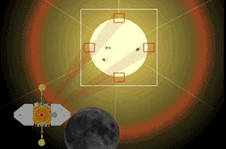Image: NASA's SDO observes a lunar transit

On July 26, 2014, from 10:57 a.m. to 11:42 a.m. EDT, the moon crossed between NASA's Solar Dynamics Observatory and the sun, a phenomenon called a lunar transit.
This happens approximately twice a year, causing a partial solar eclipse that can only be seen from SDO's point of view. Images of the eclipse show a crisp lunar horizon, because the moon has no atmosphere that would distort light.

Provided by NASA





















